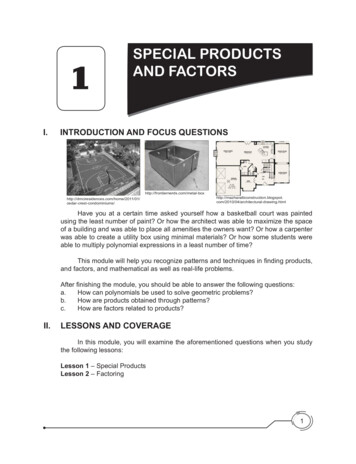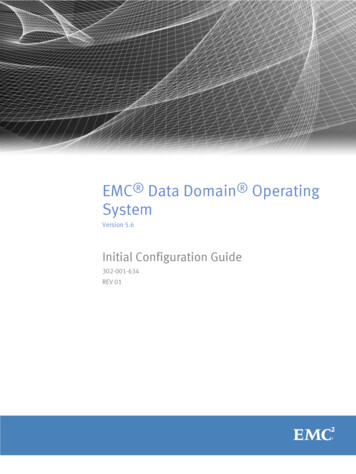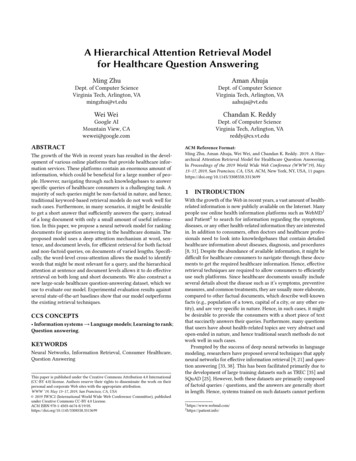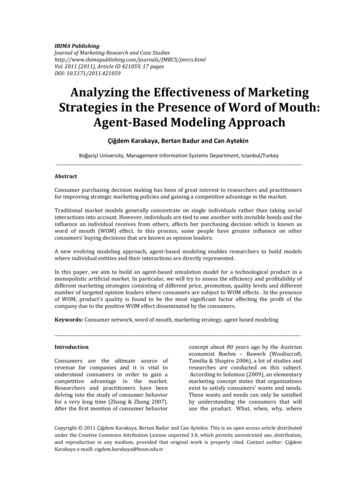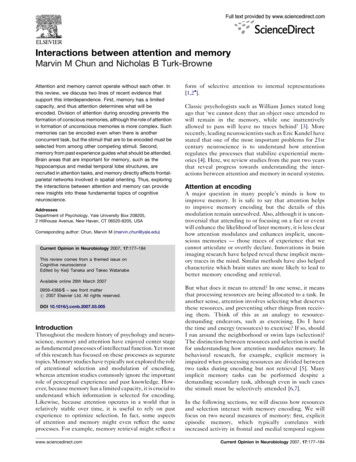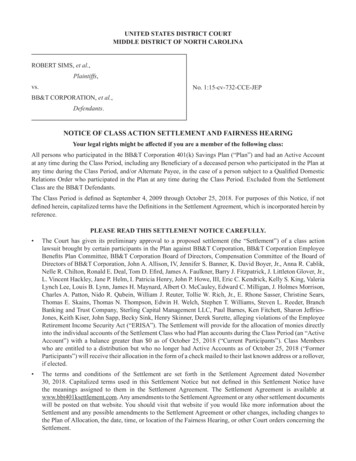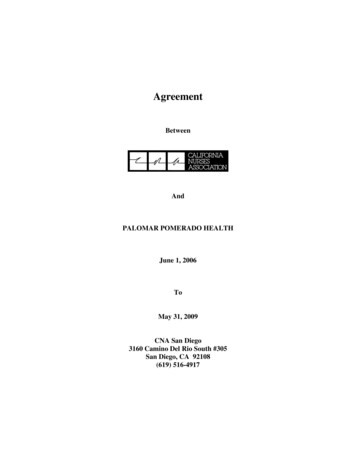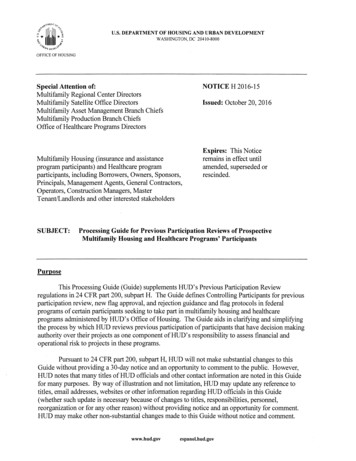
Transcription
U.S. DEPARTMENT OF HOUSING AND URBAN DEVELOPMENTWASHINGTON, DC 20410-8000OFFICE OF HOUSINGSpecial Attention of:NOTICE H 2016-15Multifamily Regional Center DirectorsMultifamily Satellite Office DirectorsMultifamily Asset Management Branch ChiefsMultifamily Production Branch ChiefsOffice of Healthcare Programs DirectorsIssued: October 20, 2016Expires: This NoticeMultifamily Housing (insurance and assistanceprogram participants) and Healthcare programparticipants, including Borrowers, Owners, Sponsors,Principals, Management Agents, General Contractors,Operators, Construction Managers, MasterTenant/Landlords and other interested stakeholdersSUBJECT:remains in effect untilamended, superseded orrescinded.Processing Guide for Previous Participation Reviews of ProspectiveMultifamily Housing and Healthcare Programs' ParticipantsPurposeThis Processing Guide (Guide) supplements HUD's Previous Participation Reviewregulations in24 CFR part 200, subpart H. The Guide defines Controlling Participants for previousparticipation review, new flag approval, and rejection guidance and flag protocols in federalprograms of certain participants seeking to take part in multifamily housing and healthcareprograms administered by HUD's Office of Housing. The Guide aids in clarifying and simplifyingthe process by which HUD reviews previous participation of participants that have decision makingauthority over their projects as one component ofHUD's responsibility to assess financial andoperational risk to projects in these programs.Pursuant to 24 CFR part 200, subpart H, HUD will not make substantial changes to thisGuide without providing a 30-day notice and an opportunity to comment to the public. However,HUD notes that many titles of HUD officials and other contact information are noted in this Guidefor many purposes. By way of illustration and not limitation, HUD may update any reference totitles, email addresses, websites or other information regarding HUD officials in this Guide(whether such update is necessary because of changes to titles, responsibilities, personnel,reorganization or for any other reason) without providing notice and an opportunity for comment.HUD may make other non-substantial changes made to this Guide without notice and comment.www.hud.govespanol.hud.gov
This Guide updates and clarifies previous procedures and supersedes outstanding policy andguidance concerning previous participation review found in previous Housing notices and in thefollowing: Multifamily Accelerated Processing (MAP) Guide Handbook 4430.G, Multifamily AssetManagement and Project Servicing Handbook 4350.1, Healthcare Mortgage Insurance ProgramHandbook 4232.1, and Mortgage Insurance for Hospitals 4615.1. HUD will incorporate elementsof this Guide into these handbooks. In addition, the Guide supersedes the Previous Participation(HUD-2530) Handbook 4065.1.Applicability of the Previous Participation Review:This Guide applies to Covered Projects administered by the Office of Multifamily Housingand the Office of Healthcare Programs, as listed in HUD' s regulations in 24 CFR Part 200 subpartH:a.FHA-Insured Projects. A project financed or proposed to be financed with a mortgageinsured under the National Housing Act, a project subject to a mortgage held by theSecretary under the National Housing Act, or a project acquired by the Secretary under theNational Housing Act; these may include projects that are insured under the followingsections of the National Housing Act: sections 213, 220, 221 (d)(3), 221(d)(4), 223(a)(7),223(d), 223(e), 2071223(t), 232/223(t), 242/223(t), 231, 232, 232(i), 236, 241(a), 241(t) or242;b.Housing for the elderly or persons with disabilities. Non-insured projects that includeSection 202 Direct Loans or Section 202 or Section 811 Capital Advances;c.Risk-share projects. Projects that are insured under sections 542(b) or 542(c) of the Housingand Community Development Act of 1992;d.Projects subject to continuing HUD requirements: Projects subject to a use agreement orany other affordability restrictions pursuant to a program administered by HUD's Office ofHousing; ande.Subsidized Projects. Projects in which 20 percent or more of the units now receive or willreceive a subsidy in the form of: Interest reduction payments under section 236 of the National Housing Act (12 U.S.c.1715z-1); Rental Assistance Payments under section 236 of the National Housing Act (12 U.S.C.1715z-1); Rent Supplement payments under section 101 of the Housing and Urban Development Actof1965 (12 U.S.C. 1701s); or Project-based rental assistance pursuant to housing assistance payment contracts under2
Section 8 of the Housing Act of 1937. This includes projects converting to PBRA assistancepursuant to the Rental Assistance Demonstration (RAD). This does not include project based assistance provided under the Housing Choice Voucher program administered byHUD's Office of Public and Indian Housing or project-based assistance provided under theMcKinney Act, administered by HUD's Office of Community Planning and Development.For the Sections 223(a)(7), 223(t), 241(a), 232(i) and 223(d) programs ControllingParticipants are only subject to Previous Participation review if they were not previously approvedto participate in that project (provided they have not changed roles in the project without priorapproval).Change in Controlling Participants:To the extent the program requirements (including without limitation any contractual documents)governing a Covered Project require HUD consent for a change in a Specified Capacity or otherControlling Participant, consent to such change is subject to Previous Participation review.Waiver AuthorityProgram offices may waive any portion of this Guide that is not a regulatory requirement, subject toan appropriate justification, as required by HUD for all waivers. HUD expects waivers to be rareand in response to unique circumstances meeting the intent ofHUD's Previous Participation reviewregulations.Program RequirementsThe sections below outline who is subject to a Previous Participation review; the submissionrequirements and review procedures; considerations for approval and rejection; and the participantflagging process.A. Controlling Participants for Previous Participation Review Purposes:Submittal of Controlling Participants. Previous Participation review is required for ControllingParticipants. In connection with each Triggering Event, Lenders in insured projects and entitiesserving in the Specified Capacities listed below in non-insured projects shall provide to HUD a listof all Controlling Participants. As stated throughout this Guide, HUD makes the ultimatedetermination of who is deemed to be a Controlling Participant. In reviewing the informationsubmitted or if circumstances change prior to final HUD approval of a Triggering Event, HUD maydetermine that other individuals or entities are Controlling Participants necessary to review.However, HUD providing final approval of a Triggering Event confirms that all ControllingParticipants with respect to that Triggering Event have been properly identified to HUD'ssatisfaction. Unless HUD discovers that individuals or entities have not been properly disclosed inaccordance with the organizational chart requirements listed in this Processing Guide, HUD shallnot change a determination of whether or not an individual or entity is a Controlling Participant afterproviding final approval for a Triggering Event.Controlling Participants are those entities and individuals (i) serving as a Specified Capacity withrespect to a Covered Project and (ii) the entities and individuals in control of the Specified3
Capacities. At least one natural person must be identified as a Controlling Participant for eachSpecified Capacity. The chart below shows the Specified Capacities for the listed programs.S.peci' fiIed C apaclles'fMultifamilyHousingOffice ofResidential CareFacilitiesOffice ofHospitalFacilitiesBorrower or OwnerXXXManagement AgentXXXXXXXOperatorGeneral ContractorXConstruction ManagerXXMasterTenantlLandlordXControlling Participants. The entities serving as a Specified Capacity are Controlling Participants ofthe Covered Project for the programs listed. In addition, the individuals and entities determined byHUD to exercise financial or operational control over these entities are also Controlling Participants.Controlling Participants require Previous Participation review and must complete PreviousParticipation review submissions. Any individual or entity who exercises financial or operationalcontrol of a Specified Capacity is considered to be a Controlling Participant and required tocomplete a Previous Participation review submission, unless excluded below. ControllingParticipants include both entities and natural persons. If a Controlling Participant is an entity, thesubmission must include the people who exercise the day-to-day financial or operational control forthat entity. Notwithstanding the foregoing or anything else in this Guide, ifHUD determines that anindividual or entity does not actually exercise financial or operational control of a Covered Projector Specified Capacity, such individual or entity shall not be considered a Controlling Participant.List of Controlling Participants: For purposes of Previous Participation review, unless excludedbelow or otherwise determined by HUD not to be a Controlling Participant, the following shall beconsidered to exercise financial or operational control over the listed entities and shall be consideredControlling Participants:1.Entities and individuals owning, directly or indirectly, 25% or more of a Specified Capacity.2.The controlling owners (entities and/or individuals) of the entity that controls the SpecifiedCapacity, these include individuals or entities with the ability to direct the SpecifiedCapacity to enter into agreements relating to the Triggering Event, including without4
limitation individuals or entities that own at least 25 percent of entities detennined to controlan entity that is a Specified Capacity.3.Any officers and other equivalent executive management (including Executive Director andother similar capacities) of the Specified Capacity or Controlling Participant who aredirectly responsible to the board of directors (or equivalent oversight body) and who havethe ability to prevent or resolve violations or circumstances giving rise to flags related to theCovered Project.4.Managers or managing members of Limited Liability Companies (LLCs).5.General partners of limited partnerships, including "administrative" general partners or othergeneral partners if they exercise day-to-day control over the entity.6.Partners in a general partnership.7.Executive Director (or equivalent position) of a non-profit corporation.8.With respect to non-profit Borrowers under the Section 242 program, the executivemanagement (Chief Executive Officer, Chief Financial Officer, and Chief OperatingOfficer, or equivalents) of the Borrower and the members of the Board of Directors thatHUD determines have control over the finances or operation of the hospital (typically thePresident, Vice President, Treasurer, and Chainnan of the Finance Committee, orequivalents).9.Members of a for-profit corporation's Board of Directors who are also officers of thecorporation.10.Controlling stockholders of a corporation. A controlling stockholder is the holder ofsufficient voting stock or shares in a corporation to prevail in any stockholders' motion. Inmost cases the controlling stockholder will be subject to the previous participation filingrequirements of those owning at least 25% of a Specified Capacity or ControllingParticipant. However, this listing is meant to trigger filing requirements for shareholderswho may technically evade the 25% ownership filing requirement but exercise financial oroperational control over the Specified Capacity.11.Trustees of a trust.12.For real estate investment trusts (REITs), the REIT itself, the chief executive officer (orequivalent position) and all company officers (except those officers detennined by HUD notto exercise day-to-day control over the REIT, the Specified Capacity or the Covered Project)must file.13.For insured projects, if applicable, the person (people) and/or entity (entities) to be listed onthe Regulatory Agreement Non-Recourse Debt section.5
14.Any other person or entity determined by HUD to exercise day-to-day, financial oroperational control over a Specified Capacity. While it is unlikely, this may include anyofficers, directors or members of an executive management team who would otherwise notbe required to make a submission (even of shell entities or other entities that may fall intothe exclusions below), if such person is exercising control over the Specified Capacity. Thislisting is meant to capture those rare individuals who structure their participation so as totechnically circumvent HUD requirements but who de facto exercise control over theSpecified Capacity. HUD believes that the individuals and entities described in the listabove accurately account for the Controlling Participants in the vast majority of cases andthat invoking an additional submission through this catch-all listing should be rare.If the applicant or Mortgagee has any reason to believe that any Controlling Participant is not ofsound mind or body or is otherwise incapacitated, such information must be disclosed to HUD toreview and determine whether another individual is acting as a Controlling Participant.List of Exclusions: Except that any Specified Capacity is a Controlling Participant, and unlessotherwise determined in writing by HUD in a specific transaction to exercise day-to-day control of aCovered Project or Specified Capacity, Controlling Participants do not include the following:1. Wholly-owned entities. Any entity that is 100% owned or controlled by one individualor entity is excluded. Such entities are not exercising control; the individual or entitythat wholly owns them is exercising control. An organizational chart may include oneor more tiers of wholly-owned entities. All wholly-owned entities in all tiers areexcluded.2. Shell entities. Entities that do not take actions themselves but only serve as legalvehicles through which the partners, members or owners of such entity take actions areexcluded. These entities are not exercising control; the partners, members or owners ofsuch entities are controlling. The "middle tiers" of an organizational chart are oftenshell entities.For example, if a Borrower ("Borrower LLC") has a managing member ("ManagingMember") that is a joint venture partnership of two entities ("Partner 1" and "Partner 2")and day-to-day control of Managing Member is exercised by Partner 1, then Partner 1 isthe Controlling Participant of the Borrower. In this example, neither Managing Membernor Partner 2 are actually exercising control and are excluded. If Partner 1 is itself ashell LLC, with three members, then the individual(s) or entity(ies) that exercise day-to day control of Partner 1 would be the Controlling Participant(s). If day-to-day control ofPartner 1 is exercised by Member A, then Partner 1 would be excluded and Member Awould be the Controlling Participant. If the organizational chart reflects thisarrangement and unless additional information or special circumstances warrant furtherinquiry, HUD will accept Member A's certification that it is the Controlling Participantand will not require an examination of the various entities' organizational documents toconfirm that Managing Member and Partner 1 are excluded shell entities.3.Tax credit investors. Syndicator and direct investor entities in Low-Income Housing6
Tax Credits, Historic Tax Credits, New Markets Tax Credits or other tax credits (ifHUD determines such credits are substantially similar to the listed tax credits) areexcluded unless such entities exercise day-to-day control or seek other involvement thatwould trigger the need for previous participation review. HUD may still require a so called "LLCI certification," an "Identification and Certification of Limited LiabilityInvestor Entities," "Passive Investor Certification" or any other such certification.Acceptable language for such certification is attached as an addendum to this Guide.4. Passive participants. If an entity's organizational documents specify which members,partners or owners are authorized to exercise day-to-day control of that entity, then anyother members, partners or owners who are not authorized to exercise day-to-day controlof an entity are excluded.5.Minor officers. IfHUD determines that an officer of a corporation or other entity doesnot have significant involvement in a Covered Project, such officers are excluded.Typically, "significant involvement" means an ability to prevent or resolve violations orcircumstances giving rise to flags related to the Covered Project.In the event HUD requests an officer who has not provided a Previous ParticipationReview submission to provide a submission, HUD shall accept certification from theofficer that (s)he has limited involvement in the Covered Project, does not exerciseoperational or financial control over the Covered Project and does not have the ability toprevent or resolve violations or circumstances giving rise to flags related to the CoveredProject (as listed below in Section G, "Flags").6. Members of a Board of Directors. Members of a non-profit or for-profit corporation'sboard of directors who do not exercise control over the corporation in another capacity(for example, as Executive Director or other manager or officer of the non-profitcorporation) are excluded. This exclusion does not apply to the members of boards ofdirectors of hospitals, the rule for which is specified in the Regulation and captured in #8within the Listing of Controlling Participants above.7. Less than 25% ownership interest. Unless exercising control through another capacity,members, partners, stakeholders and owners of entities with less than a 25% interest inan entity are excluded. This exclusion does not apply to any such member, partner,stakeholder or other owner of an entity ("Proposed Excluded Member") who wouldhave an interest greater than 25% if the combined percentages of all other members,partners, stakeholders or other owners (including beneficial interests in trusts) withwhom the Proposed Excluded Member has an "Identity of Interest," or a contlict ofinterest because of familial relation or common financial interest, exceeds 25%.Whether an Identity of Interest or connict of interest exists is determined by HUD. Ifthe program requirements of the applicable program in which the Covered Project isparticipating speak to Identify of Interest or conflict of interest, those programrequirements control.8. Nursing Homes and Assisted Living Facilities. With respect to projects under the7
Section 232 program, the nursing home administrator and equivalent positions inassisted living facilities are excluded.9. Publicly Held Companies. For publicly held companies, the chief executive officer (orequivalent position), the controlling shareholder (if any), and other individual(s), if any,identified as having day-to-day control over a Specified Capacity or Covered Project,including any relevant project manager(s), must file but the publicly held company shallotherwise be treated as an individual without need for other individual shareholders tofile certifications in their individual capacity or identify their social security or taxidentification numbers.10. Mortgagees. Mortgagees acting in their capacity as such are excluded.11. Public housing agencies. Public housing agencies, whether in their capacity as owningand operating public housing or otherwise, are excluded. Public housing agencies aresubject to different oversight and review by HUD's Office of Public and IndianHousing.12. No Exercise of Financial or Operational Control. Any individual or entity determined byHUD not to exercise financial or operational control of a Covered Project or SpecifiedCapacity shall not be considered a Controlling Participant.B. Organization Charts:An organization chart must be submitted for each Specified Capacity and for any entity within theorganization chart if requested by HUD. Organization charts are visual representations of theownership structure of an organization. Organizational charts are already required for theunderwriting purposes as a part ofthe application or request for most Triggering Events. ThisGuide clarities that such organizational charts shall also be submitted with the PreviousParticipation review submissions for the purposes of Previous Participation review. If theapplication or request for a Triggering Event does not otherwise require submission oforganizational charts, this Guide clarities that such organizational charts are required for purposes ofPrevious Participation review. All organization charts submitted in connection with a TriggeringEvent are considered part of the application for HUD review and subject to the certifications statingthat the application is true and complete. The organization chart must be clear enough so that aperson unfamiliar with the Covered Project and the entities involved can understand the ownershipand control structure. The organization chart must comply with the following guidelines:1.Clearly show all tiers of the ownership structure, including the members or owners of theentities listed.2.Show all participants, not just those who the Lender or Applicant considers to be principalsor Controlling Participants. HUD may accept an organizational chart without a full listingof all participants if HUD determines that such a listing would be unduly burdensome.3.Show percentages of ownership and role in the entity (e.g. Limited Partner, General Partner,Managing Member, Tax Credit Syndicator/Investor, etc.). The percentages must add to8
100%. However, if there are more than 10 holders of an ownership interest in an entity, noone with less than a 10% interest must be individually disclosed. In that case, holders withless than a 10% ownership interest in the entity may be listed as a group by indicating thetotal percentage of ownership interests held by the group and the total number of membersof the group (e.g., "8 members own portions of the remaining 12%"). For publiccompanies, shareholders holding less than 10% interest can be grouped by indicating theaggregate percentage and identified as "widely held" (e.g., "80% of shares are widelyheld"). To the extent ownership interests are aggregated, the Applicant must provide anyinformation requested by HUD regarding such interests.4.List at least one natural person, not just entities; provided, however, tax credit investors andother investors that are not exercising day-to-day control are not required to list a naturalperson.5.Provided that nothing in this Guide is meant to alter any underwriting requirements, forpurposes of Previous Participation review, with respect to tax credit investors and otherinvestors that are not exercising day-to-day control over a Specified Capacity or ControllingParticipant, only the investor entity and its percentage ownership in the Specified Capacityneed be shown; it is not necessary to show the members, partners or owners of the investorentity. HUD notes that additional information relating to investors may be requiredseparately through underwriting review.6.Each Specified Capacity must be shown on a separate organization chart (e.g. Borrower,Operator, Management Agent, Master Tenant, etc.).7.With respect to each entity on the organization chart except wholly owned entities, tax creditinvestors and other investors that are not exercising day-to-day control, the executivemanagement teams (for example, all senior officers such as CEO, CFO, President,Executive Director, etc., but not department heads or lower level management) and anymembers of a Board of Directors must be disclosed to HUD even if such individuals are notconsidered to be Controlling Participants and do not need to file Previous Participationreview submissions. Such information must be updated if it changes prior to the TriggeringEvent. HUD may accept an organizational chart without a full listing of an entity's Board ofDirectors ifHUD determines that such a listing would be unduly burdensome.C.Filing the Previous Participation Certification(1)To fulfill the Previous Participation review requirements, applicable controllingparticipant must file a Previous Participation Certification. The Previous Participation review shalloccur concurrently with the review of the application for mortgage insurance or other request forapproval of a Triggering Event. Participants may utilize either the electronic Active PartnersPerformance System (APPS) or a paper alternative. Participants should not file both an APPSsubmission and a paper form. HUD strongly encourages participants to utilize the APPS system.9
The following chart indicates which filing options are available for which programs.Filing MethodActive Partners PerformanceSystem (APPS) SubmissionMultifamilyHousing & GrantAdministrationProjectsXOffice ofResidential CareFacilitiesOffice ofHospitalFacilitiesXXORForm HUD-2S30 (paper)Consolidated Certification1Previous ParticipationSection (paper)XXX(2)It is the participant's responsibility to ensure that the filing is correct, complete andaccurate. The participant should ensure compliance with the certifications is met. Inrare instances, if there is a certification that the Controlling Participant cannot certifyto, the participant must strikethrough that certification and provide a signed letter ofexplanation.(3)As part of the Previous Participation Certification, participants are only required tolist all projects which they have participated in over the previous 10-year period.However, to the extent HUD has information that precedes the previous 10 years,HUD reserves the right to review and consider a participant's Previous Participationin federal projects beyond the 10-year period when determining whether to approveparticipation in a Triggering Event. Controlling Participants must include allprevious participation from the past 10 years in: (a) Covered Projects, (b) housingprojects with current flags under the u.s. Department of Agriculture's previousparticipation review system and (c) any other housing project participating in afederal, state or local or government program if during the Controlling Participant'sparticipation in the housing project (i) the housing project was foreclosed upon; (ii)the housing project was transferred by a deed in lieu of foreclosure; or (iii) an eventof default, or similarly termed event, was declared and remained after any applicablenotice and cure periods against the housing project or the Controlling Participantpursuant to the government program's project documents.I Consolidated Certifications are the following forms: HUD 90013-0RCF, Consolidated Certification-Borrower, HUD900l4-0RCF, Consolidated Certification-Principal of the Borrower, HUD 900 I 5-0RCF, Consolidated Certification Operator, HUD 900 17-0RCF, Consolidated Certification-Management Agent, and HUD 900 18-0RCF, ConsolidatedCertification-General Contractor.10
Active Partners Performance System (APPS) Submission InstructionsHUD has made several upgrades to the system to improve the applicant submission process. For example,HUD now allows for electronic signatures of APPS submissions, ability to upload submission packages,and has improved the baseline submission to allow for edits. HUD encourages participants to utilize theAPPS system when filing the Previous Participation Certification as it saves a substantial amount oftimeand allows for faster review of submissions by HUD reviewers.Here is a link to the APPS resources:http://portal.hud. govIhudportallHU D?src /program0 ffices/holls ing/mth!apps/a ppsmfhmFor questions about the APPS system contact the Multifamily Housing Systems Help Desk by phoneat (800) 767-7588 or Apps-F24p(@hud.gov.Step 1: SystemRegistrationThis step registers Controlling Participants in the APPS system. See the APPS QuickTips for detailed instructions on the registration huddoc?id anpsquicktins.QdfStep 2: Create aBaselineThis step establishes the organizational structure and previous participation ofControlling Participants. See Chapter 2 of the APPS Userguide for specificinstructions and screen llddoc?id chapter2.pdfThis step creates a submission for a Controlling Participant's role in a specific project.See Chapter 3 of the APPS Userguide for specific instructions and screen /hliddoc?id cha12ter3.pdfStep 3: Create aPropertySubmissionStep 4: Completethe Certificationand Submit toHUDStep 5: Uploadthe OrganizationChart with theSignature PagesIn this step Controlling Participants electronically certify to previous participationcertifications and send the submission to HUD for review. See the discussions aboveregarding what projects must be included and if there is a certification the ControllingParticipant cannot certify to. See also Chapter 7 of the APPS Userguide for specificinstructions and screen shots:h tto://oOltal.hud.lYov Ih udoortalldocliments/huddoc?id CHAPTER7. PDFThe user uploads the Organization Chart and Signature Pages into the APPS system.See Section B for a description of what the organization chart must include.Form HUD-2530 Completion Instructions2It is the participant's responsibility to assure that the Form HUD-2530 is correct, complete andaccurate.Form SectionReview certificationlanguageBlock 22InstructionsThe participant should assure that compliance with the certification is met. Seethe discussion above ifthere is a certification the Controlling Participantcannot certify to.List Pr
Operators, Construction Managers, Master Tenant/Landlords and other interested stakeholders . NOTICE H 2016-15 Issued: October 20, 2016 . Expires: This Notice remains in effect until amended, superseded or rescinded. SUBJECT: Processing Guide for Previous Participation Reviews of Prospective

